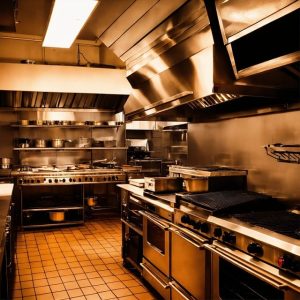 Commercial kitchen ventilation hoods, often referred to as exhaust hoods or range hoods, are essential components of any professional kitchen. They play a crucial role in maintaining a safe and comfortable kitchen environment by removing smoke, grease, odours, and heat generated during cooking. Here are some key aspects of commercial kitchen ventilation hoods.
Commercial kitchen ventilation hoods, often referred to as exhaust hoods or range hoods, are essential components of any professional kitchen. They play a crucial role in maintaining a safe and comfortable kitchen environment by removing smoke, grease, odours, and heat generated during cooking. Here are some key aspects of commercial kitchen ventilation hoods.
Types of Hoods
Wall-Mounted Hoods
These are mounted on the wall above the cooking equipment.
Island Hoods
These are suspended from the ceiling and are typically used for kitchen islands.
Under Cabinet Hoods
These are installed under cabinets above cooking appliances.
Downdraft Hoods
These are designed to retract into the countertop when not in use, and rise to capture cooking fumes when needed.
Components
Ventilation hoods have several parts. Not all are included in every system. These include:
Hood Canopy
The part of the hood that captures and contains cooking fumes.
Grease Filters
These capture grease particles to prevent them from entering the ventilation system.
Exhaust Fan
This draws in air and cooking odours and directs them through the ductwork, away from the kitchen and dining areas.
Exhaust Ductwork
This transports the grease and odour laden air outside the building.
Make-up Air System
This provides fresh air to replace the exhausted air, maintaining proper air balance.
Exhaust System Design
Properly designed ventilation systems must match the cooking equipment’s heat and pollutant output. The hood’s size, airflow capacity, and exhaust fan power should be suitable for the kitchen’s cooking load. It also obviously has to comply with local legislation. The exhaust ductwork should be sealed and insulated to prevent heat loss and condensation.
Codes and Regulations
Compliance with local building codes, health department regulations, and fire safety standards is essential. Regular maintenance and cleaning are required to prevent grease buildup and fire hazards.
Fire Suppression
Some commercial kitchen hoods may be equipped with fire suppression systems designed to automatically extinguish grease fires in the hood.
Noise Control
Ventilation systems can be noisy, so noise control measures are often needed to maintain a comfortable kitchen environment for staff and customers.
Energy Efficiency
Energy-efficient ventilation hoods and fans can help reduce operating costs and environmental impact.
Ventilation Planning
Proper kitchen ventilation design involves consulting with HVAC professionals to ensure efficient airflow and safety. The hood should be located to capture pollutants effectively and provide comfortable working conditions for kitchen staff.
Maintenance
Regular cleaning of grease filters and ductwork is crucial to prevent fire hazards and maintain optimal ventilation performance.
Sizing
Correctly sizing the ventilation system for the kitchen’s needs is crucial. Oversized hoods can lead to unnecessary energy consumption, while undersized hoods may not effectively capture cooking fumes.
Commercial kitchen ventilation hoods are critical for ensuring a safe and comfortable working environment, complying with regulations, and maintaining the quality of food and customer experience in restaurants, hotels, and other food service establishments. Consulting with professionals who specialize in kitchen ventilation is often necessary to design, install, and maintain an effective system.